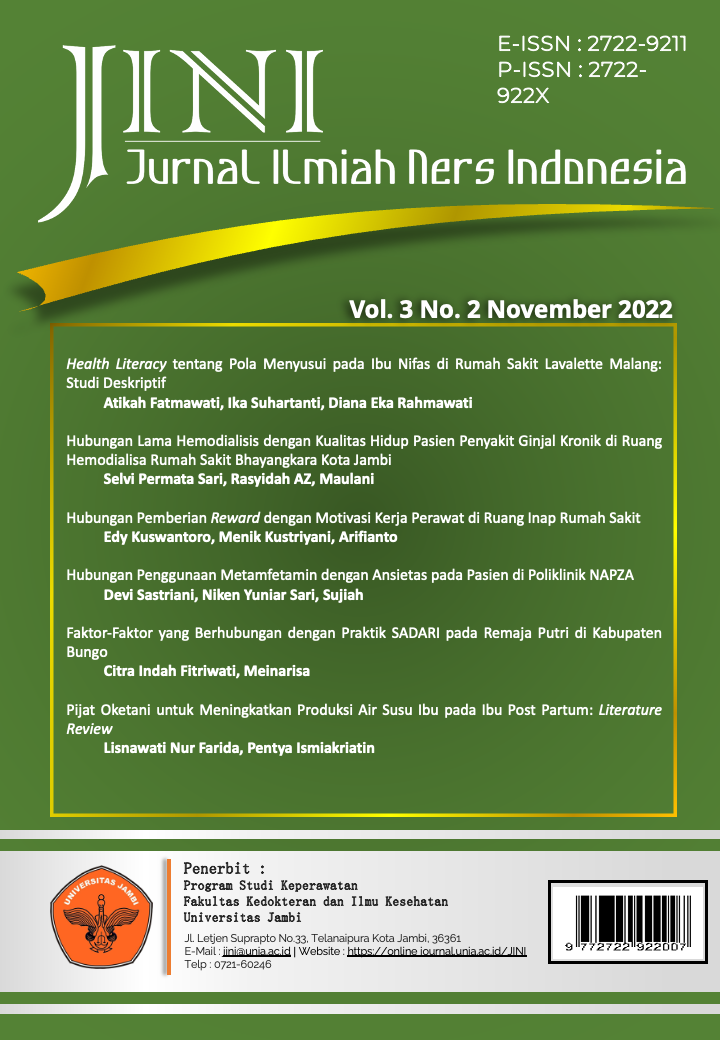Health Literacy tentang Pola Menyusui pada Ibu Nifas di Rumah Sakit Lavalette Malang: Studi Deskriptif
DOI:
https://doi.org/10.22437/jini.v3i2.20129Keywords:
health literacy, ibu, menyusui, nifasAbstract
Health literacy can affect the treatment process. The impact is that patients can use health information to access and understand the context of health services. So that it can increase access and capacity effectively through cognitive and social roles in the health sector. No exception for postpartum mothers. A lot of information must be owned and applied to care for yourself and your baby, especially regarding breastfeeding patterns. The purpose of this study was to describe the health literacy about breastfeeding patterns of postpartum mothers at Lavalette Hospital Malang. The descriptive study used the Health Literacy Survey-Short Form (HLS-SF) questionnaire. The sampling technique used quota sampling with a total sample of 30 people. Data analysis was carried out descriptively to describe health literacy about breastfeeding patterns in postpartum mothers. The results showed that the health literacy of postpartum mothers was mostly in the good category. Health literacy is influenced by several aspects, including the individual's capacity to access, understand, assess and apply the information provided. The postpartum period is one of the crucial periods in the life cycle of mothers and babies, so an adequate understanding of various information is needed. The hope is to reduce maternal mortality during the puerperium and imporve mother’s skills about good breastfeeding patterns. The ability to access, understand, assess, and apply information must be possessed by postpartum mothers so that they are not mistaken in carrying out care during the postpartum period and breastfeeding patterns can occurred properly.
Abstrak
Health literacy dapat berpengaruh pada proses perawatan. Dampaknya adalah pasien mempunyai kemampuan dalam menggunakan informasi kesehatan seperti mengakses dan memahami konteks pelayanan kesehatan. Sehingga hal tersebut dapat meningkatkan akses dan kapasitas dengan efektif melalui peran kognitif dan sosial dalam bidang kesehatan. Tidak terkecuali pada ibu nifas. Terdapat banyak informasi yang harus dimiliki dan diaplikasikan dalam upaya perawatan diri sendiri dan bayinya, khususnya terkait pola menyusui. Tujuan penelitian ini adalah untuk menggambarkan health literacy tentang pola menyusui pada ibu nifas di Rumah Sakit Lavalette Malang.
Studi deskriptif menggunakan kuesioner Health Literacy Survey-Short Form (HLS-SF). Teknik sampling menggunakan quota samplingdengan jumlah sampel sebanyak 30 orang. Analisis data dilakukan secara deskriptif untuk menggambarkan health literacy tentang pola menyusui pada ibu nifas.
Hasil penelitian menunjukkan health literacy pada ibu nifas sebagian besar berada pada kategori baik. Health literacy dipengaruhi oleh beberapa aspek meliputi kapasitas individu untuk mengakses, memahami, menilai dan mengaplikasikan informasi yang diberikan.
Masa nifas adalah salah satu masa yang krusial dalam siklus kehidupan ibu dan bayi, sehingga diperlukan pemahaman berbagai macam informasi yang adekuat. Harapannya adalah dapat menurunkan angka kematian ibu pada masa nifas dan meningkatkan keterampilan ibu tentang pola menyusi yang baik. Kemampuan untuk mengakses, memahami, menilai, dan mengaplikasikan informasi harus dimiliki oleh ibu nifas, agar tidak salah dalam melakukan perawatan pada masa nifas dan pola menyusui dapat terjadi secara baik.
Kata kunci: health literacy, ibu, menyusui, nifas
Downloads
References
Fortuna, R. R. D., & Yudianti, I. (2018). Waktu Pemberian Asi Dan Kejadian Ikterus Neonatorum. Jurnal Informasi Kesehatan Indonesia (JIKI), 4(1), 43-52.
Institute of Medicine. (2004). Health Literacy: A prescription to end confusion. Woshington, D. C: The Institute of Medicine & The National Aacademies Press.
Jessica Zibellini, Danielle Marie Muscat, Nathalie Kizirian, Adrienne Gordon. (2021). Effect of health literacy interventions on pregnancy outcomes: A systematic review. Women and Birth. 34 (2). 180 – 186. https://doi.org/10.1016/j.wombi.2020.01.010.
Larisa A.J. Barnes, Lesley Barclay, Kirsten McCaffery, Parisa Aslani. (2019). Complementary medicine products: Information sources, perceived benefits and maternal health literacy. Women and Birth. 32 (6). 493 – 520. https://doi.org/10.1016/j.wombi.2018.11.015.
Nanny, Vivian. (2011). Asuhan kehamilan untuk kebidanan. Jakarta : Salemba Medika.
Nutbeam, D. (2000). Health Literacy as a Public Health Goal: a Challenge for Comtemporary Health Education and Communication Strategies info The 21 st Century. Health Promotion International, 15 (3), 259-267.
Singleton, K., Krause, E. (2009). Understanding Culutural and Linguistic Barriers to Health Literacy, The Online Journal of Issues in Nursing, 14 (3).
Tanuwijaya, R. R., Djati, W. P. S. T., & Manggabarani, S. (2020). Hubungan Pengetahuan Pemberian Makanan Bayi dan Anak (Pmba) Ibu Terhadap Status Gizi pada Balita. Jurnal Dunia Gizi, 3(2), 74-79.
Wolf, M. S. et al. (2007). to err is human: patient misinterpretations of prescription drug label instructions; patients education and counseling. http://www.pec-journal.com/article/S0738-3991(07)00141-3/pdf.
Wiliiams, M.V., Baker, D. W., Honig, E. G., Lee, T. M. & Nowlan, A. (1998). Relationship of Funcyional Health Literacy to Patients Knowledge of Their Chronic Disease. Arch Intern Med.
Downloads
Published
How to Cite
Issue
Section
License
Copyright (c) 2022 Jurnal Ilmiah Ners Indonesia

This work is licensed under a Creative Commons Attribution-NonCommercial-ShareAlike 4.0 International License.
Jurnal Ilmiah Ners Indonesia (JINI) memberikan akses terbuka terhadap siapapun agar informasi dan temuan pada artikel tersebut bermanfaat bagi semua orang. Semua konten artikel Jurnal ini dapat diakses dan diunduh secara gratis, tanpa dipungut biaya, sesuai dengan lisensi creative commons yang digunakan.

Ciptaan disebarluaskan di bawah Lisensi Creative Commons Atribusi-BerbagiSerupa 4.0 Internasional.















